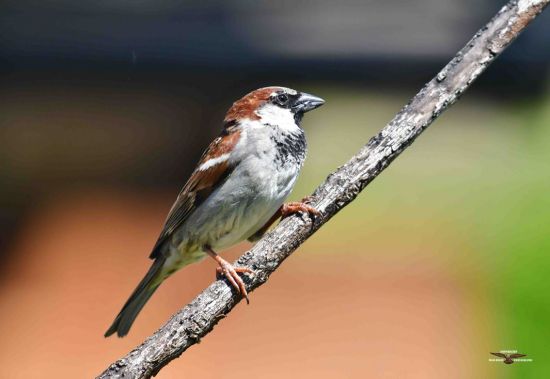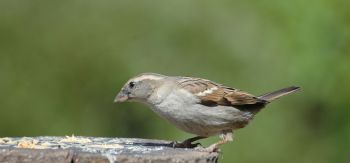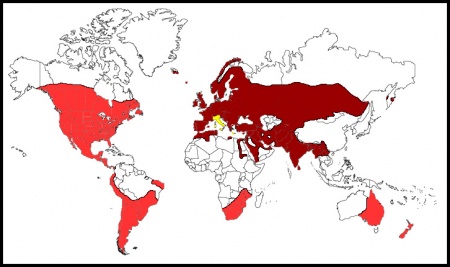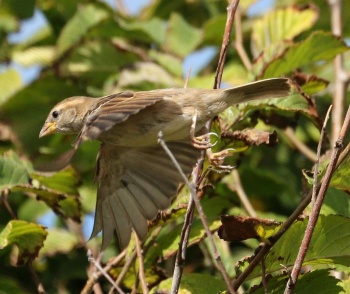- Passer domesticus
Includes: Indian Sparrow
Identification

Photo © by Meggie Francis
Hongya, Sichuan, China, 5 March 2009
L 16–18 cm (6-7 in).
Male
- Grey crown with chestnut sides
- Black lores and eye region
- Bold black bib with whitish throat sides, most prominent in the breeding season. Cheeks dusky grey (white in bactrianus and indicus)
- Heavily black-streaked brownish back
- Broad white wing-bar
- Horn coloured bill (black in breeding season)
Female
- Duller without head pattern
- Cream eyestripe (lacking in the male)
- Heavily black-streaked brownish back
Juveniles are similar to females but paler and more washed-out
Similar species
Especially females are similar to females of other species like Italian Sparrow, Spanish Sparrow, Russet Sparrow or Iago Sparrow. Sind Sparrow is very similar but smaller.
Distribution
Nearly worldwide. Deliberately introduced by man on several continents, this bird is an unwelcome addition to the local ecologies, and another glaring example of the folly of the introduction of an alien species. They are now widespread on all the continents but Antarctica, and compete with native species. In the UK their numbers have been in severe decline over the years and they are now on the "Red List" of species at risk.
| Legend • Original range |
Taxonomy
Twelve or more subspecies share the original distribution area, with P. d. indicus being smaller with whiter cheeks and more rufous in the crown. P. d. bactrianus is similar to P. d. indicus and is found in a different habitat than P. d. domesticus in the same area. In Central Asia P. d. domesticus is a resident species while P. d. bactrianus migrates to the Indian Subcontinent. Some authors therefore split P. d. bactrianus (with P. d. indicus) as Indian Sparrow.
Italian Sparrow has traditionally been included in House Sparrow, but some authorities think it is a form of Spanish Sparrow, some think it may be a stable population of hybrids between House and Spanish Sparrows, and there are more and more sources treating it as a full species. Below is a link to a discussion thread on the taxonomic status of this form.
Subspecies
There are 12 subspecies[1]:
- P. d. domesticus: Europe east to Mongolia, south central Siberia (mouth of the Amur River), and northeastern China, also locally also east on Sakhalin and the Kamchatka Peninsula. The species, probably mostly this subspecies, also is widely introduced around the world, including in North America, South America, sub-Saharan Africa, Australia, New Zealand, and elsewhere, primarily in populated areas
- P. d. balearoibericus: Mediterranean Spain, Balearic Islands, France, Balkans to Asia Minor
- P. d. tingitanus: North West Africa (Morocco to Tunisia, Algeria and north-eastern Libya)
- P. d. rufidorsalis: Nile Valley of the Sudan
- P. d. niloticus: North East Africa (Suez Canal region to northern Sudan)
- P. d. biblicus: Cyprus and Levant to Turkey, northern Saudi Arabia, Iraq and westerm Iran
- P. d. indicus: southern Israel and most of the Arabian Peninsula east to southern Iran, India, Sri Lanka, and southeast Asia east to Laos; also introduced in South Africa
- P. d. hufufae: North East Arabia (south to northern Oman)
- P. d. bactrianus: Transcaspia to Kazakhstan, Afghanistan and north-westerm Pakistan
- P. d. hyrcanus: North Iran (south to Elburz Mountains) and adjacent Turkmenistan
- P. d. persicus: Central Iran to south-western Afghanistan and extreme western Pakistan
- P. d. parkini: Himalayas (Pakistan to south-western Tibet, Nepal and Sikkim)
Habitat
Mostly around human settlement.
Subspecies Bactrianus and parkini are found in grassland along riverbanks and avoid human settlement.
Behaviour

Photo © by the late Donny Taylor
Wayne County, North Carolina, November 2018
Breeding
Nests of grass, wool, feathers and other soft materials are made in holes in buildings or other structures, though house sparrows will also breed in thick ivy and natural structures. The clutch consists of 4-5 glossy pale blue eggs which are incubated for about 12 days. The young fledge after about 3 weeks. There may be up to 4 broods in the season which runs from April to August (UK), though 2-3 broods is more normal.
Diet
Includes seeds, soft buds, fruit, insects, spiders and any food scraps from humans or on bird tables.
Vocalisation
A flock of about 200 sparrows, recorded at Titchwell bird reserve, Norfolk
This is the classic sparrow chirp, often heard at length (up to half an hour!) in the Spring from an unmated male at the nest site trying to attract a female; although most persistent at that time the chirp can be heard from either sex all year round though for much shorter periods. Observation seems to indicate that as well as the breeding period usage of attracting a mate this call is also used to keep the flock aware of where other individuals are. A lone sparrow arriving may start up a chirp which attracts other sparrows. There is another variant of this, which has a disyllabic chirr-up, giving rise to an old English name for the house sparrow, "Phyllip sparrow" where the "phyll-ip" is onomatopoeic It is the loudest vocalisation of this bird.
This 'chattering' sound is common where there are sparrows in proximity. Although it is hard to avoid an anthropomorphic association with angry scolding, observation shows this sound can also be uttered by an individual on discovering a new food source, and may therefore also simply draw attention. It is also used to warn of ground predators
Low level churrs. Though the house sparrow is a common bird not many people have heard this sound because it is emitted at a fairly low level. This was recorded about six inches from sparrows feeding at a confined location (squirrelproof mealworm feeder) and seemed to enable the sparrows to feed in a closer proximitiy to each other (< 1 inch) than even this social bird normally permits.
References
- Clements, J. F., T. S. Schulenberg, M. J. Iliff, S. M. Billerman, T. A. Fredericks, J. A. Gerbracht, D. Lepage, B. L. Sullivan, and C. L. Wood. 2021. The eBird/Clements checklist of Birds of the World: v2021. Downloaded from https://www.birds.cornell.edu/clementschecklist/download/
- Lowther, P. E. and C. L. Cink (2020). House Sparrow (Passer domesticus), version 1.0. In Birds of the World (S. M. Billerman, Editor). Cornell Lab of Ornithology, Ithaca, NY, USA. https://doi.org/10.2173/bow.houspa.01
- Bird Watching
- Discussion thread about the taxonomy of Italian Sparrow
- BTO House Sparrow Information sheet
- RSPB House Sparrow page
- Kate Vincent House sparrow decline PhD thesis Kate Vincent studied potential reasons for the decline between 2000 and 2005 part sponsored by the RSPB and English Nature.
Recommended Citation
- BirdForum Opus contributors. (2025) House Sparrow. In: BirdForum, the forum for wild birds and birding. Retrieved 16 May 2025 from https://www.birdforum.net/opus/House_Sparrow
External Links
GSearch checked for 2020 platform.1











